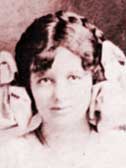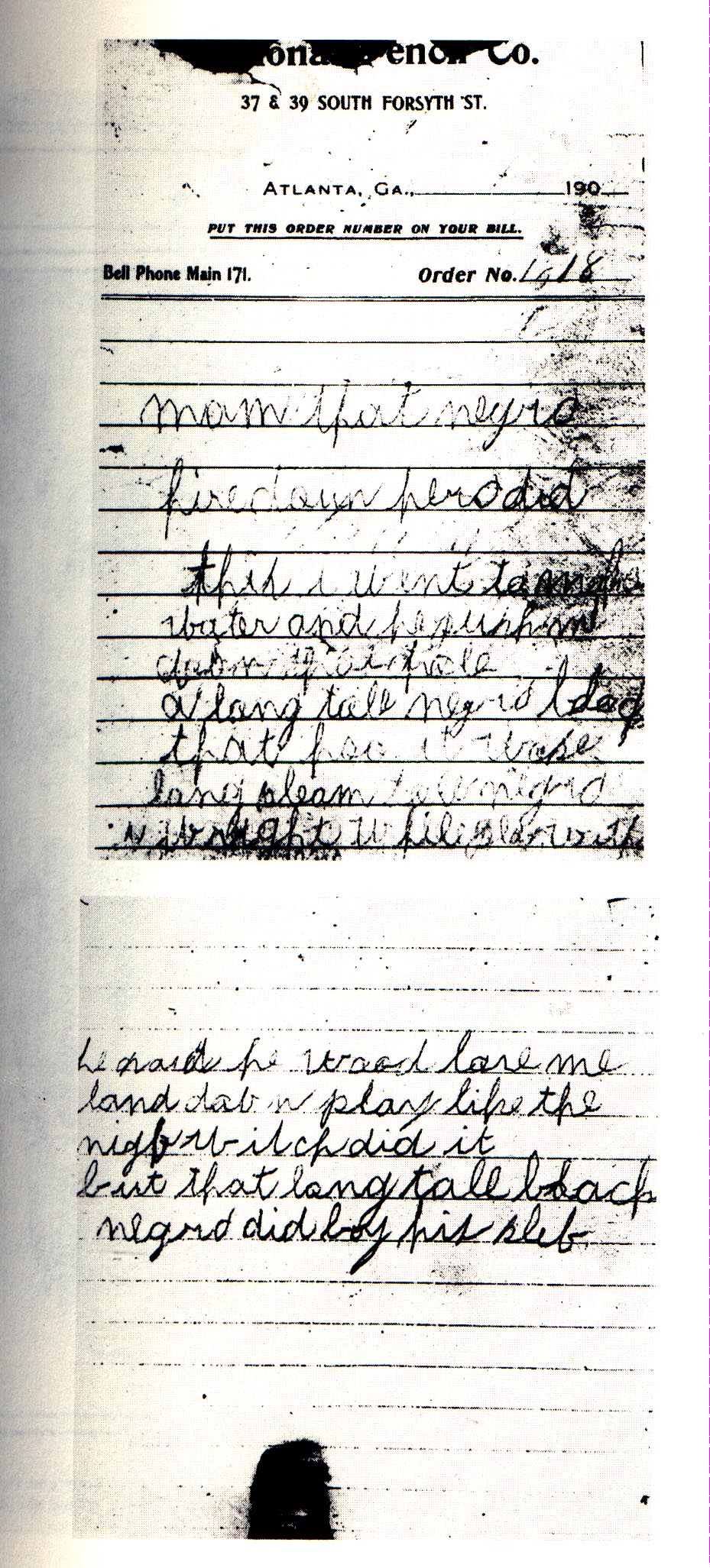"Those notes are negro notes from beginning to end. They are
idiotic and ridiculous and inconceivable to the intelligent brain…This note
says, ‘he push me down that hole’. There is no ‘hole’ she could have been pushed
down in the metal room, but there are two holes on the ground floor at the
bottom of the steps. One is the elevator shaft, the other is the trap door down
which the ladder leads. Conley, knowing that he pushed the girl down one of
these holes, unconsciously brings this fact out in the note… " – Reuben Arnold
"It is my opinion that there is not a white man, either north or south
of the Mason & Dixon line, that could have dictated those notes. If Frank
did not dictate the notes, then Conley was the murderer." - Berry Benson.
"Conley saw that he must come up with an explanation for the
notes. So he says they were written so that if he never came back to burn the
body they would explain the killing. Yet Frank had no reason to believe the
negro would not come back. Was ever an explanation more preposterous?" - Reuben
Arnold
“Why should Frank seek assistance from an unreliable and perhaps
treacherous negro merely to take the body down the elevator?.. Why should he
wish to leave a clue as to his confederate’s identity by having him write two
notes? Or why, if the notes were written upstairs, and the body taken down in
the elevator, did Frank tell the negro to write that ‘he push me down that
hole’? Why ‘hole’ at all? And what became of the purse and the money?” - Arthur
Train
“The purpose of the note was to divert suspicion, which would
immediately be defeated by the handwriting itself, which was not Mary Phagan’s…
Frank would have known that instantly, but Conley was capable of no such logic.
He placed the pencil and the notes and the pad by the body to make people
believe Mary Phagan had written the notes in the cellar. He thought that the
police would recognize it as a negro’s crime, and he makes the notes describe a
negro. He knew that the crime occurred in the basement, and so he picks the man
[William Nolle] who was employed down there. He never dreamed of the storm of
prejudice that would swirl around Frank and make it so easy for him to say, and
be believed, that Frank had dictated the notes.” - C.P. Connolly
"How did Frank know that Mary wasn't going to come on Monday or Tuesday?... And how did he know no one else would be in his office when she got there? He's a smart man, but he's not a seer." - Luther Rosser.
"Finally, Darley could credibly advance the thesis that Frank's behavior on the morning Mary's body was discovered, far from being suspicious, was typical. Recalling a day several years before when Frank arrived at work after having seen a child run over by a streetcar, [Darley] told [defense counsel] Arnold: 'He came in about 2:30 and he couldn't work any more on his books until a quarter after four. He trembled just as much on that occasion as he did on the Sunday after Mary Phagan was killed.'". - Oney, p. 232
"Leo Frank was convicted by lies heaped on lies. It wasn't just Conley who lied. Others said that Leo Frank had women in his office for immoral purposes and that he had liquor there. There was a story that he took women down in the basement. That cellar was filthy. It was filled with coal dust. I was in the basement twice and remember the dirt and filth there. That was all false. Leo Frank was a good office manager. He was always proper with people who worked for him. There were witnesses who told lies and I remained silent." - Alonzo Mann
About three quarters of the witnesses, including George Epps and most of the factory girls, later signed sworn affidavits admitting that they had perjured themselves. This did not constitute grounds for a new trial under Georgia law. [Oney, pp. 372-73, 389, 418]). Neither did new evidence. The only grounds for a new trial were "errors in law". Since there were no "errors in law" (they saw to that -- after that, they convicted him, didn't they?) -- everything was kosher and the sentence could be upheld 13 times, all the way to the Supreme Court and back, with a lot of double-talk. Typical lawyer stuff.
Epps was such a fantastic liar that he claimed to be able to tell the time to within seven minutes by the sun (ibid, p. 198).
Frank never told Newt Lee to stay out of the basement, which was normally inspected every half hour (ibid, p. 202).
The body was ritualistically or fetishistically "arranged" in the basement in a manner not in accordance with the prosecution theory of the case (ibid, p. 391-92).
It is worth noting that at the time of the murder the National Pencil Company shared the front entrance to the building with another business, the Clark Woodware Company, and that Frank had no authority to lock the front door (ibid, p. 319). There was no lock on the main door to the metal room (ibid, p. 232); Conley is supposed to have unlocked the front door and admitted Monteen Stover to the building even though he had just heard Mary Phagan scream from the metal room; a scream from the metal room could not be heard from the front lobby (ibid, p. 436). Travelling salesmen often stopped by Frank's office on Saturdays; nobody ever found the front door locked.
[THE LINES STRICKEN THROUGH ARE HEREBY WITHDRAWN AND ARE PROBABLY UNTRUE] It is obvious that the prosecutors knew that Frank was innocent and simply sacrificed him to further their own political ambitions. For example, the victim was bitten on the left shoulder and neck. Photographs of the bite wounds were taken and compared with X-rays of Frank's teeth. They did not match (Golden, p. 65; Oney, pp. 617-18).This was never mentioned at trial and this information was never made available to the defense. It is obvious that the comparison was made, otherwise why bother to obtain Frank's dental X-rays in the first place?
There were fingerprints on the victim's throat (Oney, p. 93). Don't tell me they were Frank's, because in that case we would have heard about it in 1913: they would have constituted incontrovertible proof that Frank was guilty. Instead, we are supposed to believe that no comparison was ever made. We are also supposed to believe that Conley went to prison twice after the trial and his fingerprints were never taken. Can you really go to prison in Georgia as an accessory to murder and for armed robbery and never be fingerprinted?
Conley's lawyer (who by that time believed Conley to be the murderer) attempted to obtain Conley's fingerprints while Conley was on the chain gang, and Conley refused to cooperate (Oney, p. 435). By some curious coincidence (just in case anybody else comes along and tries to prove Frank was innocent) all the material and documentary evidence has disappeared, including the X-rays, photographs, other documents (Oney, p. 647) and trial transcript (Oney, p. 666)!
There were bloody fingerprints on the exit door to the factory basement (Golden, p. 39; Oney, p. 92) but Conley's fingerprints were never taken. Frank was fingerprinted (Dinnerstein, p. 4, Golden p. 49, Oney p. 104), but when they didn't match, nobody ever thought of fingerprinting Conley! Or so we are told (Oney, p. 436).
(A DUTCH JEW NAMED VAN PASSENS HAS BEEN ACCUSED OF FABRICATING THE EVIDENCE OF THE BITE MARK AND X-RAY IN 1964. IN ANY CASE, THERE IS, TODAY, NO PROOF THAT THEY EVER EXISTED. THE FINGERPRINTS DID EXIST BUT WERE APPARENTLY NEVER COMPARED WITH CONLEY'S.)
To sum up:
There were 2 notes, only one of which mentions the "night wich". Even if "night wich" means "night watch", instead of "night witch", a common element of African folklore, a clear distinction is still made between the "night wich" and the "long, tall negro black".
They are clearly 2 different entities or people. The same note says the "night wich" didn't do it. What is the sense of that?
There were 2 notes, only one of which mentions the "night wich". Why write 2?
A Negro would automatically be suspected of the crime. What difference would it make to Frank which one?
How would the notes implicate Newt Lee, the night watchman, if they were in Conley's handwriting? The notes led the police to Conley, who led the police to Frank. Anyone could have predicted this. Or did Frank think the police would think they were written by the victim during the act of rape? "I wright while play with me". What is the sense of that?
If Frank was guilty, and Conley knew it, or even had any evidence of Frank's guilt, he was in a position to blackmail Frank for very large sums of money. Conley could have lived a life of luxurious drunkenness for the rest of his days. Why put his head in a noose for a few dollars? What criminal "dictates" a note leading the police straight to his accomplice? What is the logic of this?
I repeat: those who disagree with me can answer one question: how would the notes implicate Newt Lee, the night watchman, if they were in Conley's handwriting?
I await an answer. I don't care about anything else.
This is actually a number of questions in one:
a) Why would a college graduate like Frank
b)
believe that the police would believe
c)
that Newt Lee would write a note
d) which the police, again, were expected to believe
e) was actually written by the dead girl during commission of the crime
f) when it was not even in Lee's handwriting -- but Conley's --
g) containing all kinds of statements like "he push me down that hole"
h) which do not even fit the prosecution theory of the crime?
It's like "The House that Jack Built" -- an infinite regress of stupidity.
In 40 years I've never gottten an answer and it seems safe to wager that I never will.
A few years ago, the webmaster of www.LeoFrank.org admitted to me by email that the notes were "an absurdity".
I pounced immediately, saying, "So you admit you believe in an absurdity?"
He changed the subject.
--
For the original Skunkie page which started all this, see:
http://67.225.133.110/~gbpprorg/judicial-inc/MiscPics.htm
--
Update 4 August 2015
-C.P.


